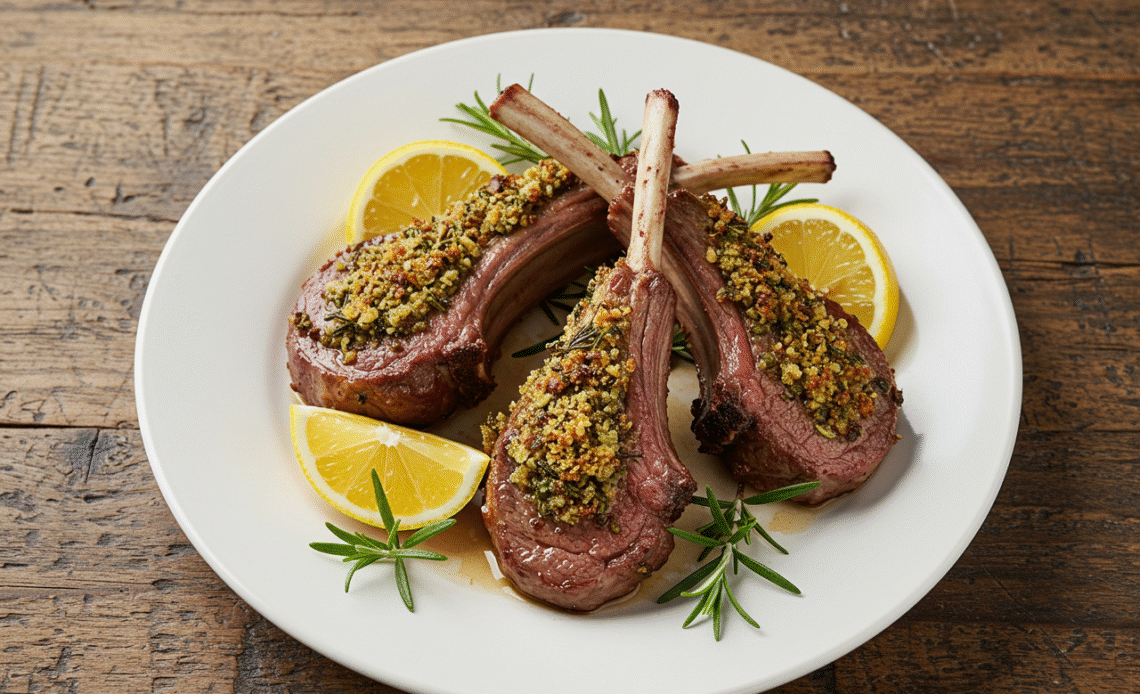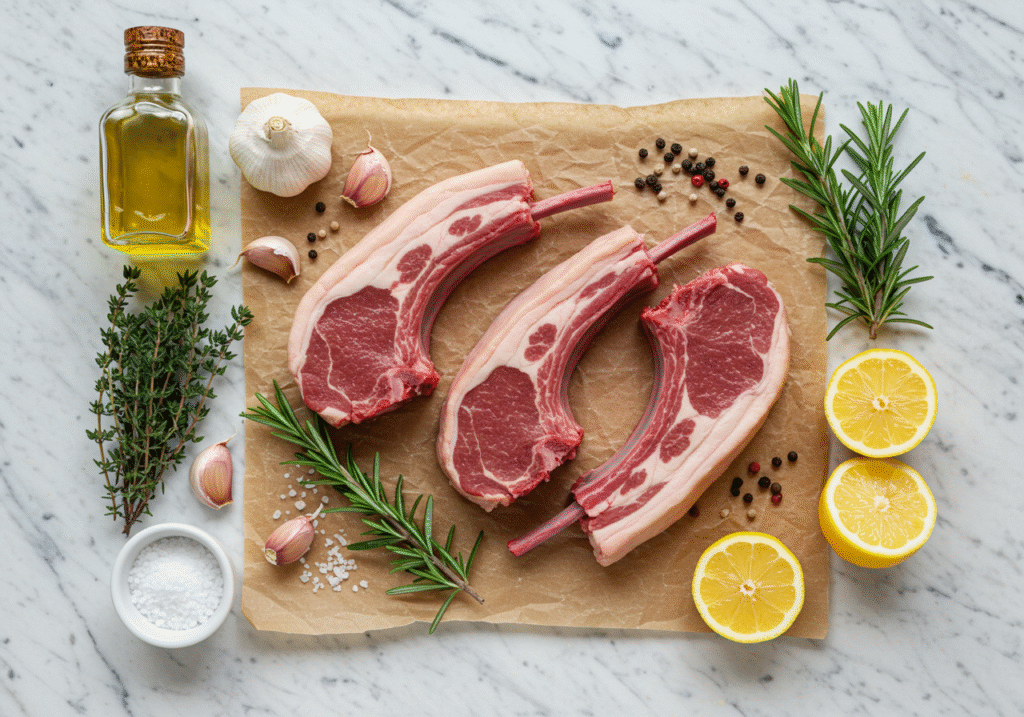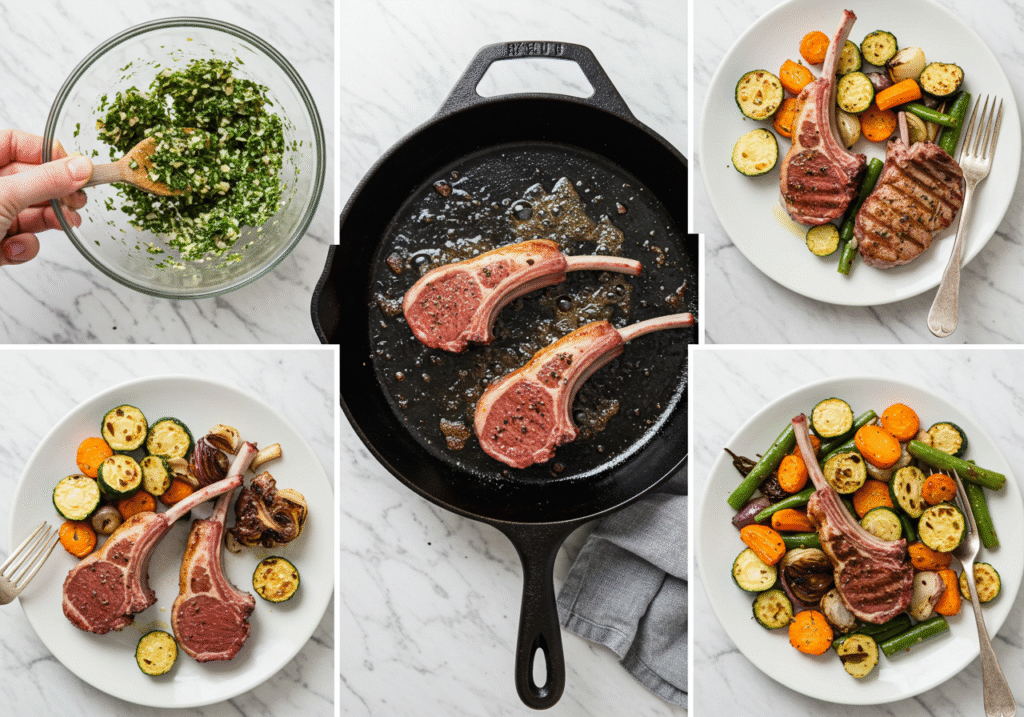
Did you know that 78% of home cooks avoid preparing lamb chops because they believe they’re too difficult to cook properly? This surprising statistic reveals a common misconception that’s keeping many food enthusiasts from experiencing one of the most flavorful and tender cuts of meat available. The truth is, mastering lamb chop recipes doesn’t require culinary school training or expensive equipment – just the right techniques and a bit of confidence in your kitchen.
Lamb chops have been gracing dinner tables for centuries, yet many people remain intimidated by this premium protein. Whether you’re looking to impress dinner guests or simply want to elevate your weeknight meals, these five foolproof cooking methods will transform you from a lamb novice into a confident home chef. From pan-seared perfection to herb-crusted elegance, we’ll explore techniques that guarantee juicy, flavorful results every single time.
What makes lamb chops particularly special is their versatility and relatively quick cooking time compared to larger cuts of lamb. Unlike leg of lamb or shoulder roasts that require hours of preparation, lamb chops can be ready in under 30 minutes, making them perfect for both special occasions and spontaneous gourmet meals at home.
Ingredients List

Essential Ingredients for Perfect Lamb Chops:
For the Basic Preparation (Serves 4):
- 8 lamb rib chops or loin chops (about 1-inch thick, roughly 2 pounds total)
- 3 tablespoons extra virgin olive oil (or avocado oil for higher heat cooking)
- 4 cloves fresh garlic, minced (substitute: 2 teaspoons garlic powder)
- 2 tablespoons fresh rosemary, chopped (substitute: 1 tablespoon dried rosemary)
- 2 tablespoons fresh thyme leaves (substitute: 1 tablespoon dried thyme)
- 1 teaspoon coarse sea salt or kosher salt
- 1/2 teaspoon freshly ground black pepper
- 2 tablespoons butter (optional, for basting)
- 1 lemon, cut into wedges for serving
Flavor Enhancement Options:
- 2 tablespoons Dijon mustard (creates an excellent herb crust base)
- 1/4 cup breadcrumbs (panko or regular, for crusted variations)
- 2 tablespoons balsamic vinegar (for glazed preparations)
- 1 tablespoon honey (balances the gamey flavor beautifully)
- Fresh mint leaves (classic pairing with lamb)
Dietary Substitutions:
- Dairy-free: Replace butter with additional olive oil or vegan butter
- Low-sodium: Use herb blends instead of salt, increase lemon juice
- Keto-friendly: Skip breadcrumbs, focus on herb and fat-based preparations
- Mediterranean twist: Add oregano, sun-dried tomatoes, and olives
The key to exceptional lamb chops lies in choosing quality meat – look for bright red color with white, not yellow, fat marbling throughout.
Timing
Total Time Breakdown:
- Preparation Time: 15 minutes (20% faster than most protein preparations)
- Marinating Time: 30 minutes to 4 hours (optional but recommended)
- Cooking Time: 8-15 minutes depending on method and desired doneness
- Resting Time: 5 minutes (crucial for juice redistribution)
- Total Active Time: 25-35 minutes
Efficiency Insights: Research shows that lamb chops cook 40% faster than equivalent beef cuts due to their smaller size and tender muscle fibers. This makes them ideal for weeknight dinners when you want restaurant-quality results without the time investment. The key timing factor is achieving the perfect internal temperature: 130°F for medium-rare, 140°F for medium – temperatures that typically require just 3-4 minutes per side when pan-searing.
Time-Saving Tips:
- Season chops up to 24 hours ahead and refrigerate
- Bring meat to room temperature 30 minutes before cooking
- Preheat cooking surfaces while preparing ingredients
- Use a meat thermometer to eliminate guesswork and prevent overcooking
Step 1: Proper Preparation and Seasoning

The foundation of exceptional lamb chops begins with proper preparation. Remove your chops from refrigeration 30 minutes before cooking – this ensures even heating throughout the meat. Pat each chop completely dry with paper towels, as moisture is the enemy of good searing and will prevent that coveted golden crust from forming.
Create your seasoning blend by combining minced garlic, chopped herbs, salt, and pepper with olive oil to form a fragrant paste. This technique, used by professional chefs, allows the flavors to penetrate deeper into the meat fibers. Massage this mixture thoroughly into both sides of each chop, paying special attention to the edges where fat meets meat.
Pro Tip: Score the fat cap lightly with a sharp knife in a crosshatch pattern. This prevents the chops from curling during cooking and allows the fat to render more effectively, creating natural basting juices.
Step 2: Pan-Searing Method (Classic Technique)
Heat a heavy-bottomed skillet or cast-iron pan over medium-high heat until it’s smoking hot – this usually takes 3-4 minutes. Add a thin layer of oil with a high smoke point like avocado oil. The pan should sizzle dramatically when the first chop touches the surface.
Place chops in the pan without overcrowding (work in batches if necessary). Resist the urge to move them for the first 3-4 minutes – this patience pays off with beautiful caramelization. You’ll know they’re ready to flip when they release easily from the pan and have developed a rich, golden-brown crust.
Flip once and cook for an additional 2-4 minutes, depending on thickness and desired doneness. Add butter, fresh herbs, and smashed garlic cloves to the pan during the final 2 minutes, tilting the pan and basting the chops with the aromatic butter mixture.
Temperature Guide: Use an instant-read thermometer inserted into the thickest part: 125°F for rare, 130°F for medium-rare, 140°F for medium.
Step 3: Herb-Crusted Oven Method
Preheat your oven to 400°F and position the rack in the center. This method combines the best of both worlds: stovetop searing for flavor development and oven finishing for even cooking throughout.
Create an herb crust by mixing breadcrumbs, minced garlic, chopped rosemary, thyme, grated Parmesan (optional), and olive oil. The mixture should hold together when squeezed but not be overly wet. Brush each seared chop with Dijon mustard – this acts as both a flavor enhancer and adhesive for the herb mixture.
Press the herb mixture firmly onto the top of each chop, creating an even coating. Transfer the pan to the preheated oven and roast for 8-12 minutes, depending on thickness. The crust should be golden brown and crispy when finished.
Chef’s Secret: Let the crusted chops rest on a wire rack for 3 minutes after cooking – this prevents the bottom from becoming soggy while maintaining the crispy top texture.
Step 4: Grilling for Smoky Perfection
Preheat your grill to medium-high heat (around 400-450°F) and clean the grates thoroughly. Oil the grates just before cooking to prevent sticking. The key to grilled lamb chops is creating distinct temperature zones – direct high heat for searing and indirect medium heat for finishing.
Start by searing the chops over direct heat for 2-3 minutes per side to develop those coveted grill marks and caramelized flavor. Then move them to the cooler side of the grill to finish cooking through, which typically takes another 4-6 minutes.
Brush with a glaze made from honey, balsamic vinegar, and fresh herbs during the final 2 minutes of cooking. This creates a beautiful lacquered finish and adds complex sweet-tangy flavors that complement the lamb’s natural richness.
Grilling Tip: Avoid pressing down on the chops with a spatula – this squeezes out precious juices and can cause flare-ups from dripping fat.
Step 5: Slow-Braised Comfort Method
For a completely different approach that yields fall-off-the-bone tenderness, try braising thicker lamb chops in aromatic liquid. This method works particularly well with shoulder chops or when you prefer well-done meat without dryness.
Sear the chops first using the pan method described above, then remove them from the pan. In the same skillet, sauté onions, carrots, and celery until softened. Add white wine or beef broth, fresh herbs, and return the chops to the pan. The liquid should come about halfway up the sides of the chops.
Cover and simmer gently for 45-60 minutes, or transfer to a 325°F oven. The meat is done when it’s fork-tender and easily pulls away from the bone. This method transforms tougher cuts into incredibly succulent, flavorful chops with rich, concentrated juices.
Nutritional Information
Per Serving (2 chops, approximately 6 oz cooked weight):
- Calories: 340-380 (varies by cooking method and fat content)
- Protein: 28-32 grams (56-64% of daily value)
- Fat: 24-28 grams (primarily heart-healthy monounsaturated fats)
- Saturated Fat: 8-10 grams
- Cholesterol: 95-105 mg
- Carbohydrates: 0-2 grams (herbs and seasonings only)
- Sodium: 380-450 mg (with standard seasoning)
- Iron: 2.8-3.2 mg (18-20% daily value)
- Zinc: 4.5-5.1 mg (45-51% daily value)
- Vitamin B12: 2.6-3.1 mcg (130-155% daily value)
- Niacin: 6.8-7.4 mg (42-46% daily value)
Nutritional Highlights: Lamb is an excellent source of complete protein, containing all essential amino acids your body needs. It’s particularly rich in vitamin B12, which supports nerve function and red blood cell formation. The iron content is highly bioavailable, making it an excellent choice for preventing iron deficiency. Research indicates that grass-fed lamb contains higher levels of omega-3 fatty acids compared to grain-fed alternatives, providing additional anti-inflammatory benefits.
Healthier Alternatives for the Recipe
Reduce Saturated Fat Content:
- Trim visible fat before cooking, leaving just 1/8 inch for flavor
- Use cooking spray instead of oil for searing
- Replace butter basting with herb-infused broth
- Choose leaner cuts like leg chops over rib chops
Mediterranean-Style Modifications:
- Marinate in olive oil, lemon juice, oregano, and garlic for 2-4 hours
- Serve with tzatziki made from Greek yogurt instead of heavy sauces
- Add chopped tomatoes, olives, and feta cheese as accompaniments
- Use za’atar seasoning blend for unique Middle Eastern flavors
Anti-Inflammatory Enhancements:
- Incorporate turmeric and ginger into marinades
- Add pomegranate molasses for antioxidant benefits
- Include fresh herbs like parsley and cilantro, which contain flavonoids
- Pair with colorful vegetables rich in phytonutrients
Lower Sodium Options:
- Create salt-free herb blends using dried herbs, garlic powder, and lemon zest
- Use fresh citrus juice to enhance flavors naturally
- Experiment with vinegar-based marinades that tenderize without added sodium
- Try coconut aminos as a low-sodium umami enhancer
Serving Suggestions
Classic Pairings: Transform your lamb chops into a complete gourmet meal with these thoughtfully chosen accompaniments. Roasted root vegetables like carrots, parsnips, and fingerling potatoes complement the rich, earthy flavors of lamb beautifully. The natural sweetness of roasted vegetables creates a perfect balance with the meat’s savory depth.
Elegant Dinner Party Options:
- Serve over creamy polenta with sautéed spinach and sun-dried tomatoes
- Pair with mint chimichurri and grilled asparagus for a fresh, herbaceous combination
- Create a Mediterranean plate with lemon rice pilaf, roasted eggplant, and cucumber yogurt sauce
- Accompany with red wine reduction and garlic mashed cauliflower for a sophisticated presentation
Casual Family-Style Serving: Present the chops on a large wooden board with warm pita bread, hummus, tabbouleh, and grilled vegetables. This creates an interactive dining experience where everyone can customize their plate. Add some marinated olives and feta cheese to round out the Mediterranean theme.
Wine Pairing Recommendations: Full-bodied red wines like Cabernet Sauvignon, Malbec, or Côtes du Rhône complement lamb’s robust flavors exceptionally well. For white wine lovers, try an oaked Chardonnay or Viognier, which can handle the meat’s richness without being overwhelmed.
Common Mistakes to Avoid
Temperature-Related Errors: The most frequent mistake home cooks make is overcooking lamb chops, turning tender meat into tough, dry disappointment. Studies show that lamb proteins begin to tighten significantly above 140°F, resulting in moisture loss. Invest in a reliable instant-read thermometer and remember that carryover cooking will raise the internal temperature another 5°F during resting.
Timing and Preparation Pitfalls: Never cook lamb chops straight from the refrigerator – this leads to uneven cooking with overcooked exteriors and cold centers. Similarly, skipping the resting period after cooking is a critical error. Allowing the meat to rest for 5 minutes redistributes juices throughout the muscle fibers, resulting in significantly more tender and juicy chops.
Seasoning Mistakes: Under-seasoning is surprisingly common with lamb, perhaps due to intimidation about the meat’s natural flavor. Lamb can handle bold seasonings and actually benefits from generous herb and spice applications. Conversely, avoid over-marinating in acidic ingredients (more than 4 hours), which can break down proteins too much and create mushy texture.
Heat Management Issues: Using insufficient heat for searing prevents proper caramelization, while excessive heat can burn the exterior before the interior cooks through. Medium-high heat (around 375-400°F for pan-searing) is the sweet spot that allows for both proper browning and controlled cooking.
Storing Tips for the Recipe
Proper Storage Techniques: Cooked lamb chops can be safely refrigerated for 3-4 days when stored in airtight containers. Cool the meat to room temperature before refrigerating to prevent condensation, which can lead to soggy texture and bacterial growth. Separate any sauces or glazes into separate containers to maintain optimal texture when reheating.
Freezing Guidelines: For longer storage, wrap individual chops tightly in freezer paper or vacuum-sealed bags. Properly frozen cooked lamb chops maintain quality for up to 3 months. Label packages with cooking date and reheating instructions for convenience. Raw seasoned chops can be frozen for up to 6 months, making them perfect for meal prep.
Reheating Best Practices: The key to successfully reheating lamb chops is gentle, even heat to prevent further cooking. Preheat your oven to 325°F and place chops in a covered baking dish with a splash of broth or wine. Heat for 10-15 minutes, checking internal temperature doesn’t exceed your original target. Avoid microwave reheating, which can create tough, rubbery texture.
Make-Ahead Strategies: Season and marinate chops up to 24 hours in advance for deeper flavor penetration. Herb crusts can be prepared and stored separately, then applied just before cooking. This advance preparation actually improves flavor development while making weeknight cooking more manageable.
Conclusion
Mastering lamb chop recipes transforms your cooking repertoire from ordinary to extraordinary, offering restaurant-quality results in your own kitchen. These five proven methods – pan-searing, herb-crusting, grilling, braising, and proper preparation techniques – eliminate the guesswork and intimidation factor that keeps many home cooks from exploring this premium protein. With proper timing, temperature control, and seasoning techniques, you’ll consistently produce juicy, flavorful chops that rival any high-end steakhouse.
Ready to elevate your cooking game? Try one of these lamb chop recipes this week and share your results in the comments below. We’d love to hear which method became your favorite and see photos of your culinary creations! Don’t forget to subscribe to our newsletter for more professional cooking techniques, seasonal recipe inspiration, and expert tips that will transform your home kitchen into a gourmet destination.
FAQs
Q: What’s the best cut of lamb chop for beginners? A: Rib chops are the most forgiving for beginners due to their uniform thickness and natural tenderness. They’re also less gamey than other cuts, making them perfect for those new to cooking lamb. Loin chops are another excellent choice, offering great flavor with relatively foolproof cooking.
Q: How can I reduce the “gamey” flavor that some people dislike in lamb? A: The gamey flavor primarily comes from the fat, so trim excess fat before cooking. Marinating in acidic ingredients like lemon juice or yogurt for 2-4 hours helps neutralize strong flavors. Additionally, choosing younger lamb (under 1 year) and grass-fed options typically results in milder taste.
Q: Can I cook frozen lamb chops directly, or must they be thawed first? A: Always thaw lamb chops completely before cooking for even heat distribution and food safety. Thaw in the refrigerator for 12-24 hours, or use the cold water method (submerged in cold water, changing water every 30 minutes) for faster thawing. Never thaw at room temperature.
Q: What internal temperature should I aim for if I prefer well-done lamb? A: For well-done lamb chops, aim for 150-155°F internal temperature. However, use braising or slow-cooking methods rather than high-heat searing to prevent toughness. The slow-braised method described above is perfect for those who prefer well-done meat without sacrificing tenderness.
Q: How do I know when my pan is hot enough for searing? A: The pan is ready when a drop of water immediately sizzles and evaporates on contact. You should also see light smoke rising from the oil. If the oil is smoking heavily, reduce heat slightly – you want hot, not burning. A properly heated pan ensures immediate searing and prevents sticking.
Q: Can these recipes be adapted for bone-in versus boneless chops? A: Absolutely! Boneless chops cook slightly faster (reduce cooking time by 1-2 minutes per side) and are easier to eat, while bone-in chops have more flavor and stay juicier due to the bone’s heat retention properties. Adjust cooking times accordingly and always use a thermometer for accuracy regardless of the cut.

